

Click here to
return to previous page.
Abstracts
of Presentations:
(alphabetical order of first author)
........Images
from Limpets 2003, Millport, Scotland
21.
Broadcast spawning in storms: implications for the appropriate scale
of limpet harvest management
W.J.F. LE QUESNE, S.J. HAWKINS AND J.G. SHEPHERD
University of Southampton & Marine Biological Association, Plymouth,
U.K.
Broadcast spawning in storms has been shown or suggested for several
inter-tidal and shallow water species including limpets. At first
glance it would seem that free spawning into such a turbulent environment
would lead to rapid dispersal and dilution of gametes leading to low
rates, or complete failure of fertilisation. However increasing information
about the hydrodynamics of the near shore environment shows that this
area is not completely mixed and that structure within the water column
occurs over a range of spatial and temporal scales. Furthermore if
fertilisation is increased by the interaction of gametes from many
individuals it is necessary to understand how the dispersal, advection
and fertilisation of gametes is related to structures within the water
column, and the scales over which these processes occur. For example
studies on sandy beaches (a simplified case compared to more topographically
complex rocky shores) have shown that wave action leads to the formation
of near shore circulation cells with a scale of 10’s to 100’s
of meters and within which the decay of dye concentrations have a
half-life of 10’s of minutes to hours. On a smaller scale within
the surf zone of a rocky shore it has been shown that small wave surge
channels with a scale of meters have a half-life for dye dispersal
of 10’s of seconds. If the interaction of the gametes from many
individuals to ‘saturate’ these structures is necessary
for high levels of fertilisation it maybe necessary to manage populations
at the scale of these hypothesised ‘fertilisation cells’
to ensure adequate larval production.
Return
22.
The past decade of patellogastropod research foci: advances, syntheses
and the future
DAVID R. LINDBERG
Department of Integrative Biology & Museum of Paleontology, University
of California at Berkeley
At the first Limpet Symposium held in London (17 Sept. 1993) the topics
covered by the participants ranged from nomenclatural issues to ecology
and evolution. Cladistic analysis, molecular sequencing, gene expression
data, metadata analysis, etc. were rare or non-existent. The application
of these new techniques and approaches has both supported and overturned
some of our previous interpretations of the biology and history of
the Patellogastropoda (or true limpets). Other long ignored areas
such as patellogastropod embryology have experienced a resurgence
of interest as modern molecular techniques have probed early development.
Ecological studies and manipulations have also become more sophisticated
over the last 10 years, and the basal position of the Patellogastropoda
relative to other clades of the gastropod tree has become increasingly
robust. Today the patellogastropods are one of the best known of the
gastropod taxa, and while they lack the fan-base of the cowries, cones
and other coveted snails, they far surpass these other marine groups
in our collective understanding of their biology, ecology, and evolution.
This knowledge-base, combined with increasing interest and support
for large scale biodiversity studies and the growing understanding
of the importance of ‘tree thinking’ in biological inquiry,
make the Patellogastropoda a likely contender as a model clade amongst
marine invertebrate groups.
Return
23.
Homing in Collisella subrugosa (Orbigny) - What do we know, Where
do we go?
MAGALHÃES, C. A., TANAKA, M. O., DUQUE-ESTRADA, T.E.M.
AND HARA, H. E.
Departamento de Zoologia, Instituto de Biologia, Universidade Estadual
de Campinas, Campinas, São Paulo, Brasil. E-mail: clau...@unicamp.br
Collisella subrugosa is the most common limpet in the Brazilian midlittoral.
Homing in this species has being studied in subtropical rocky shores
of Southeastern Brazil since 1992. Limpets were most abundant in the
low midlittoral, dominated by the barnacle Tetraclita stalactifera.
Vertical distribution on the shore covered the entire midlittoral.
In natural rocky patches opened on mussel beds in the mid midlittoral,
55 to 60% of the limpets presented homing behavior, with average densities
of 0.28 individuals/cm2. The limpets negatively affected the densities
of small mussels, but did not interfere with recruitment of small
barnacles . Limpet activity was higher in conditions of periodic wave
splash (rising and falling tides) than in full submersion or emersion.
There was not any difference between diurnal and nocturnal activity.
It was experimentally established that periodic wetting triggers Collisella
moving activity. While resting, around 50% of marked individuals in
mid midlittoral exhibited homing behavior, and only 12% in low midlittoral.
Homing was of short duration (3 to 4 months/individual). Within a
specific rocky patch, the limpets presenting homing alternated their
resting positions with each other. Average monthly distance from the
original home site was 2 cm. Twenty five percent of the individuals
remained strictly faithful to a specific home site for 6 months. Limpet
recruitment was continuous, with a peak in the summer. In natural
rocky patches among mussel beds, closure rates were much faster in
the ones where Collisella individuals were constantly removed. Thus,
Collisella slowed down succession rates on mussel beds.
Return
24.
Climate change and species interactions: the role of Fucus patches
in influencing the distribution of a northern and southern species
of limpet
PIPPA MOORE1,2, RICHARD C. THOMPSON1 AND STEPHEN J. HAWKINS2
1University of Plymouth, Drakes Circus, Plymouth, PL4 8AA, United
Kingdom
2Marine Biological Association of UK, Citadell Hill, Plymouth, PL1
2PB, United Kingdom
The distribution of many species is expected to alter in response
to climate change. However predictions for the extent of these shifts
are generally based on anticipated changes in temperature alone. Here
the rocky intertidal is used to investigate how the balance of northern
and southern species may also be influenced by biological interactions.
In northern Europe the abundance of many intertidal organisms is influenced
by the presence of large fucoid algae which provide a refuge from
desiccation and temperature. Macroalgae are predicted to move northwards
as a result of climate change. The effects of macroalgal cover on
the relative abundance of a northern and southern species of limpet,
which play a key role in structuring semi-exposed shores of the NE
Atlantic, was examined on shores in south-west Britain.
Results show that the southern/Lusitanian limpet Patella depressa
does not aggregate under Fucus and the proportion of P. depressa decreases
with increasing Fucus cover. In contrast it has been demonstrated
that the northern/boreal limpet P. vulgata does aggregate under Fucus.
Manipulative field experiments where Fucus is removed showed that
P. vulgata disaggregates while P. depressa does not. The implication
of differing limpet behaviour and its effect on Fucus escapes is discussed
in relation to climate change.
Return
25.
The effect of limpet grazing and rock substratum on microbial films
MOSCHELLA1, R.C. THOMPSON AND 1.S.J. HAWKINS2
1.University of Plymouth, 2Marine Biological
Association of the UK
On rocky shores, epilithic biofilms, which consist mainly of cyanobacteria,
diatoms, algal sporelings and germlings, represent the major food
resource for limpets. Limpet grazing therefore plays an important
role in limiting the abundance and distribution of both macro- and
micro-algal communities. Few investigations, however, have focused
on the effects of grazing on microalgal communities. Also, very little
is known on the importance of the rock substratum in modulating the
effect of limpet grazing on microbial communities. This study aimed
to investigate the relative importance of limpet grazing and rock
substratum on epilithic microbial communities. The effects of these
two factors and their putative interactions on biofilms were experimentally
tested on a rocky shore in Wembury Bay (Devon). Microalgal biomass
(measured as chlorophyll-a) and composition of biofilms colonising
experimental tiles of different rock type (chalk and dolomite) were
assessed in exclusion plots, where limpets were removed, and in control
areas. After 60 days, microbial colonisation was significantly depressed
by limpet grazing on both rock types. The rock substratum appeared
to affect microbial films in the exclusion plots, where microalgal
biomass was significantly higher on chalk than on dolomite. In the
control plots, however, microalgal abundance did not differ between
chalk and dolomite, suggesting an interaction between the effects
of grazing and rock substratum on biofilms. Possible explanations
for the patterns observed are explored.
Return
26.
Phylogeny and biogeography of the limpets of the order Patellogastropoda
(Gastropoda: Prosobranchia) determined from mitochondrial DNA sequences
TOMOYUKI NAKANO, SEIJI HAYASHI AND TOMOWO OZAWA
Department of Earth and Planetary Sciences, Graduate School of Environmental
Studies, Nagoya University, Chukusa-ku, Nagoya 464-8602, Japan. oza...@eps.nagoya-u.ac.jp
The limpets of the order Patellogastropoda are of particular evolutionary
interest as they are one of the most abundant gastropods on rocky
shores around the world, and are phylogenetically recognized as a
basal branch of the extant gastropods. We determined DNA sequences
from mitochondrial 12S and 16S rRNA gene segments (830bp) for 43 species
distributed in 9 genera of the Patellogastropoda, derived from the
Northern Pacific. Molecular phylogenetic trees were constructed by
the neighbor-joining analysis based on the present and previously
published (Koufopanou et al. 1999) data, representing most living
members of the order. In the resultant phylogenetic trees, two major
clades, named here as (A) the Tethyan-peri Gondwana and (B) the Pacific
clades, were recognized with higher bootstrap supports. Each clade
consists of three subclades, which nearly accord with geographical
distribution as follows: (A1) Northeastern Atlantic, (A2) Southern
Africa + Australasia, (A3) Australasia + Western Pacific, (B1) Northern
Pacific, (B2) Northwestern Pacific, (B3) Southwestern Pacific. Approximate
divergence time was estimated using reliable fossil records as reference
dates. Divergence of the two major clades was likely as ancient as
the early Jurassic. Molecular phylogeny suggests that principal geographic
clades were formed during the late Mesozoic in association with the
tectonic and marine environmental events connected with the disruption
and dispersal of Pangea.
Return
27.
The limpet Patella vulgata and the study of evolutionary developmental
biology
ALEXANDER J. NEDERBRAGT
Kewalo Marine Laboratory, University of Hawaii, Honolulu
At the interface between evolutionary biology and developmental biology
is the so-called field of evolutionary developmental biology (‘evo-devo’
in short). This field asks how different adult animals (species) came
into being by heritable changes during their embryonic development.
One way to study this question is a comparative analysis of genes
that are important for the development of different species. Many
genes appear to be conserved during evolution, i.e. the same gene
often has a comparable role during the development of very different
species. However, the range of species studied so far is limited.
For example, very little is known on the genetics of early development
of molluscs. Within molluscs, limpets, and in particular the limpet
Patella vulgata, turn out to be an excellent starting point for evolutionary
developmental analysis. I discuss recent results concerning cloning
and spatio-temporal mRNA expression analysis of P. vulgata homologs
of several genes known from other organisms. Besides expression comparable
to that in other species, novel aspects of expression related to structures
specific for molluscs, such as the shell, were found. These results
add to our understanding of what is the most likely ancestral function
of these genes, and how very different animals can be generated from
similar sets of genes.
Return
28.
The structure of the egg ribbons of a planktonic and direct developing
siphonariid limpet
(Gastropoda: Pulmonata)
PURBA PAL AND ALAN N. HODGSON
Department of Zoology & Entomology, Rhodes University, Grahamstown
6140, South Africa
Egg ribbons of two sympatric species of siphonariid limpets (Siphonaria
capensis and S. serrata) with different life history strategies were
studied to compare their structural and biochemical differences. The
structure of the egg ribbons was examined by light, transmission and
scanning electron microscopy. The organic content of the egg ribbons
was determined by TCA soluble carbohydrate, NaOH soluble protein and
total lipid estimation. Although the structural composition of the
egg mass is similar in both species, the spawn of S. serrata (a direct
developer) appears more fibrous and has a greater amount of carbohydrate
and protein than that of S. capensis (which has planktonic development).
S. serrata also produces egg capsules with a thicker wall compared
to S. capensis. It is suggested that these differences make the egg
masses of S. serrata more robust, enabling them to survive for longer
periods on the shore.
Return
29.
Accessory reproductive gland (glandular complex) of Siphonaria capensis
and S. serrata: structure and function
PURBA PAL AND ALAN N HODGSON
Department of Zoology & Entomology, Rhodes University, Grahamstown,
South Africa
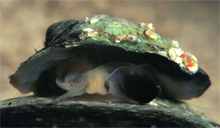
Siphonaria capensis
|
The
anatomy, histology and ultrastructure of the glandular complex
from the reproductive system of two sympatric species of Siphonaria
are described and compared. The tubular glandular complex is composed
of an albumen gland and a mucous gland although the subdivision
is not always discrete. Both glands contain numerous columnar
to cuboidal secretory cells and highly ciliated supporting cells.
Only one type of secretory cell could be identified in each gland
although cells often showed different levels of activity. The
secretory cells of both glands stained positively for neutral
as well as acidic mucopolysaccharides. Protein was only detected
in albumen gland cells. The possible role(s) of the glandular
complex in egg mass formation will be discussed. |
Although the ultrastructure
of the glands is similar to that of other Euthyneurans, the simpler
arrangement of these glands suggests a more primitive condition.
Return
30.
Spatial organization of foraging activity in Siphonaria lessoni from
the SW Atlantic, Argentina
PABLO E. PENCHASZADEH, MAXIMILIANO CLEDÓN AND GREGORIO BIGATTI
Museo Argentino de Ciencias Naturales, Av. A. Gallardo 470, 1045 Buenos
Aires, Argentina.
Facultad de Ciencias Exactas y Naturales-UBA-CONICET. penc...@bg.fcen.uba.ar,
mcle...@bg.fcen.uba.ar
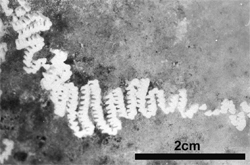 |
Siphonaria
lessoni is the only gastropod species living in the upper littoral
rocky shore in Northern Argentina. S. lessoni do not show homing
behaviour. Excursions occur during splash of wave action or rain.
Movements are shown by a zig-zag of mucus trails on vertical walls.
On horizontal surfaces of tidal pools where a thin layer of sand
is retained above the rocky substratum, S. lessoni moves leaving
a zig-zag trail visible because they sweep the sand. In order
to answer if this pattern of movement is a response to quartzose
rock, rugose surfaces, or a intrinsic limpet behaviour, a series
of aquarium observations were performed. Individuals of adult
S. lessoni were placed in an aquarium after allowing a microalgal
film to grow on the walls. |
The limpets started
to move and graze in a zig-zag pattern of increasing amplitude of
radular bites from one to fifteen as a general rule. The final result
is the almost complete depletion of the algae film of the aquarium
wall. We conclude that the zig-zag pattern of movement and grazing
is an intrinsic behaviour which is not related to microenvironmental
heterogeneity and allows the limpets to explore and cover a wider
surface area. This behaviour would be linked with the lack of homing
in the species.
Return
31.
Mineralisation of the teeth of the hydrothermal vent limpet, Eulepetopsis
vitrea
SOPHIE PENDLEBURY1 AND STEVE HAWKINS2
1.Southampton Oceanography Centre, 2
Marine Biological Association
Hydrothermal vent fluids are characterised by elevated levels of transition
metals, such as iron, zinc and copper, when compared to non-vent seawater.
Hydrothermal vent limpets graze bacteria from surfaces such as basalt
rock, mussel shells and tubeworms. A variety of techniques were used
to investigate the possibility of biomineralisation of the teeth of
Eulepetopsis vitrea, a patellogastropod. SEM coupled with EDS was
used to map the elemental concentrations of metals upon the radulae.
Histological sections of the radulae were stained with Perls’
Prussian blue and Tirmann Schmeltzer’s Turnbull’s blue
to resolve the ferric and ferrous iron. Contamination from vent fluids
and feeding surfaces was an important consideration; hence the radulae
of two hydrothermal vetigastropods with similar feeding ecologies
were examined. One radula of one vetigastropod, Cyatheriumia naticoides
did not contain significant amounts of iron, however the teeth of
the radula of Lepetodrilus elevatus were heavily coated in iron. EDS
indicated that the iron within the teeth of Eulepetopsis vitrea is
associated with silica.
Return
32.
Reproductive ecology of hydrothermal vent limpets of the genus Lepetodrilus
SOPHIE PENDLEBURY, PAUL TYLER & EELCO ROHLING
Southampton Oceanography Centre, University of Southampton
Limpets of the vent-specific genus Lepetodrilus are widespread; species
have been found at most vents so far described. They are one of the
first metazoans to settle at new vents and consequently their reproduction
and dispersal mechanisms are of particular interest. Polymodal size-frequency
distributions of Lepetodrilus elevatus populations from vents on the
EPR., coupled with increased larval counts in the summer, suggest
some form of episodicity in the recruitment or reproduction of the
limpet. In this study, three Lepetodrilus species from the EPR hydrothermal
vent system were examined, with particular emphasis on L. elevatus.
This species is the most abundant gastropod at the 9°50N (EPR)
hydrothermal vent field. The Oxygen Isotope ratios were compared in
the protoconch and the adult shell of L. elevatus. The results suggest
that larvae move into cooler waters, presumably away from the vent,
in order to disperse. The reproduction of three Lepetodrilus species
from the EPR hydrothermal system was examined using histological techniques.
As with the majority of deep sea molluscs fertilisation is internal,
maturation is early (occurring at approximately one quarter of the
maximum size), and protoconch morphology suggests a lecithotrophic
larval development. Fecundity, gametogenesis and the widespread occurrence
of sperm within the female receptaculum seminis demonstrated no reproductive
episodicity. Oocyte size-frequency distributions indicate a quasi-continuous
gametogenesis.
Return
33.
New records of Patella rustica L. in northern Portugal: misobservation
or evidence of a recent expansion?
P.A. RIBEIRO, F. P. LIMA, N. C. QUEIROZ AND A. M. SANTOS
Research Center in Biodiversity and Genetic Resources (CIBIO) and
Department of Zoology and Anthropology,
University of Oporto, Portugal
The geographical distribution of Patella rustica ranges from the Mediterranean
Sea to the Atlantic coast of the Iberian Peninsula and Northern Africa,
including the Macaronesian Islands. However, there was a well documented
distributional gap between Galicia (NW Spain) and central Portugal.
During recent surveys (Autumn, 2002) some individuals were spotted
on several sites within this gap, including in areas subject to regular
monitoring since 1993. There is a remote chance that P. rustica has
been misidentified in this area, probably due to the low densities
at which it occurs. Alternatively, these populations can be the outcome
of recent settlement, either a chance event or part of a gradual expansion
of its range, thus bridging the gap between Galician and southern
Portuguese populations. The present work, though preliminary, aimed
to test this hypothesis, by comparing size-frequency distributions
of the newly observed populations with those from well-established
southern populations.
Return
34.
Morphology and anatomy of Williamia gussonii (Siphonariidae) by 3D-visualisation
and a discussion on the taxonomic status of the species
BERNHARD RUTHENSTEINER AND SABINE SCHOPF
Zoological State Collection Munich, Muenchausenstr. 21, 81247 Munich,
Germany
E-mail: BRut...@zsm.mwn.de
Up to now the anatomy of the siphonariid genus Williamia has been
very poorly known. There is even less information on the type species
of the genus, the Mediterranean W. gussonii. Therefore the morphology
of this species has been investigated with the help of the software
package Amira 3.0 (TGS Systems) from a paraffin sectioned specimen.
Surfaces of all major organ systems and of the whole specimen were
reconstructed and partly visualised by animation. A short survey of
the major processing steps is provided. The investigation revealed
a typical siphonariid anatomy. The visceral loop of the nervous system
shows inconspicuous oesophageal ganglia and a big visceral ganglion.
The remnants of the cerebral gland, a tubiform connection from the
procerebrum to the body surface, can still be detected in the adult.
A monaulic genital system is present which lacks a bursa copulatrix,
an organ found in all other siphonariids investigated so far. Other
organ systems show no major differences to those of Siphonaria.
The species dealt with here presents a taxonomic problem. It never
has been described properly and there is no type material. O.G. Costa,
1829 is usually given as the describer. He based his description on
a figure of a fossil from the Paris Basin by Dashayes, 1824. This
figure, however, clearly shows a different species. The first person
who clearly dealt with W. gussonii was Dall, 1879, who figured the
radula and jaw. Since we are planning to go into further studies on
the systematics of Williamia, a redescription of the type species
appears to be necessary.
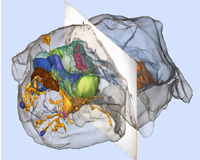 |
Williamsia
gussoni. 3D-view of body surface (transparent), nervous system
and genital system, with one ortho slice (the histological section
s on which the 3-D reconstruction is based). |
Return
35.
Molecular phylogenetic analyses of the genus Patella based on mtDNA
and protein loci
ALEXANDRA SÁ-PINTO, MADALENA BRANCO AND PAULO ALEXANDRINO
CIBIO, Universidade do Porto, Campus Agrário de Vairão,
4485-661 Vairão, Portugal
Some molecular phylogenies have been published for Patella but most
of them include a limited number of species. We sequenced 600 base
pairs (bp) of the mitochondrial gene cytochrome oxidase I (CO I) for
P. vulgata, P. depressa, P. ulyssiponensis, P. rustica, P. candei,
P. aspera and P. pellucida, and screened ten protein loci using starch
gel electrophoresis for P. vulgata, P. depressa, P. ulyssiponensis
and P. rustica. Of the 600 bp analysed 156 were polymorphic. The average
number of substitutions between species varies from 6.0 to 21.0 for
transversions and 41.0 to 70.2 for transitions. The phylogenetic tree
of CO I confirms the basal position of P. pellucida and the differentiation
between the continental and Azorean forms of P. ulyssiponensis (P.
aspera) already reported. However, there is some disagreement relative
to previous studies in the position of P.vulgata and in the degree
of differentiation found within P. ulyssiponensis. The phylogenetic
trees obtained with allozymes and mtDNA show different topologies,
which may be explained by characteristics intrinsic to each marker.
Return
36.
Patellogastropods in museum collections
JULIA SIGWART
American Museum of Natural History & Department of Zoology, University
College Dublin, Ireland
The collections of natural history museums form a basis for all research
in systematic biology, and provide data critical to assessments of
biological diversity. But in order for such data to be useful to researchers,
specimens must be accessible and something must be known about a collections'
holdings. Although the National Museum of Ireland (Natural History)
holds one of the largest collections in Europe, this resource has
never previously been evaluated as a research and teaching tool. As
animals targeted almost exclusively by scientists and amateurs with
interests more scientific than aesthetic, limpets may be useful collectively
as indicative of the diversity represented in a Malacological collection.
I compare taxonomic and biogeographic representation of patellogastropods
found in NMINH to major museums in North America. All limpet specimens
in the collections studied were coded by species-level taxon for four
families (Patellidae, Lottiidae, Acmaeidae, and Nacellidae) and by
faunal "province." It is hoped that presentation of this
information will stimulate interest in a much-underused collection.
Return
37.
A new hypothesis for New World antitropical distributions based on
the phylogeography of Lottidae
BRIAN SIMISON
Department of Integrative Biology & Museum of Paleontology, University
of California at Berkeley
New World antitropical distribution patterns have been reported for
many taxa, including many members of Lottidae. These limpets are found
in the southern temperate waters of Chile and the Northeast Pacific
while none are present in the intervening tropical waters. Several
published hypotheses for antitropical patterns have been tested using
a molecular phylogeny of New World Patellogastropods and a new hypothesis
is presented based on the phylogeography of these limpets.
Return
38.
Does Patella vulgata re-use its slime trails?
1.RICHARD C. THOMPSON, 2.STEPHEN J. HAWKINS AND 3.MARK S. DAVIES
1.University of Plymouth, 2.Marine
Biological Association of the UK, 3.University
of Sunderland
It is widely accepted that limpets re-use their mucus trails (possibly
for navigation, energy saving or food gathering). The extent and precision
of this behaviour has however not been determined. Using time-lapse
video we describe trail-following in the intertidal limpet Patella
vulgata and discuss the putative benefits.
Return
39.
Variability in growth rate of Scutellastra (Patella) granularis (Patellogastropoda)
from the south east coast of South Africa
LAURA S. VAT AND ALAN N. HODGSON
Department of Zoology & Entomology, Rhodes University, Grahamstown
6140, South Africa E-mail a.ho...@ru.ac.za
Growth rate of Scutellastra granularis inhabiting three types of intertidal
substrata (aeonlianite, quartzite and mussel shells) in the Eastern
Cape of South Africa, was estimated by measuring labelled limpets
and counting shell microgrowth bands. Estimation of growth rate using
the Von Bertalanffy growth model suggests that limpets inhabiting
low shore mussel beds grow more slowly and attain a smaller maximum
size than those inhabiting both aeolianite and quartzitic sandstone
(K = 0.25, 0.32 and 0.33 respectively; shell length 27.12 mm, 31.
89 mm and 32.96 mm respectively). When translocated from mussel beds
to other substrata limpets quickly (within a month) adjusted their
growth rate to mirror that of the resident limpets, suggesting that
limpet size in mussel beds is subjected to spatial constraints. Despite
the differences in size, limpets inhabiting all three substrata were
estimated to have a similar longevity (about 15 years). No significant
differences in seasonal growth rates were detected.
Return
40.
Patella aspera and P. ulyssiponensis: genetic evidence of speciation
in the North East Atlantic
1.LAURA I. WEBER,& 2.STEPHEN 3.J. HAWKINS
1.Port Erin Marine Laboratory, University of Liverpool, Isle
of Man
2.Laboratory Bioquímica e Biologia
Molecular, CTTMar, Universidade do Vale do Itajaí, Rua Uruguai
458, Bl 20,
S212, Itajaí-SC, Brazil. E-mail: liwe...@cttmar.univali.br
3.The Marine Biological Association of
the United Kingdom, The Laboratory, Citadel Hill, Plymouth PL1 2PB,
UK.
Patella ulyssiponensis subspecies, commonly known as P. aspera, were
studied by electrophoresis of 21 allozyme loci and by shell morphology
and radula related characters. The aim of this work was to test the
hypothesis that European mainland populations belong to a different
species than those coming from the north-west African Archipelagos.
Mdh-1 was diagnostic for distinguishing mainland from north-west African
populations, where the allele of the last group is novel for the group,
having the mainland populations a plesiomorphic character shared with
all other patellids of the north-west Atlantic. Other two loci were
partially diagnostic. They showed a genetic distance of 0.730. Morphologically,
the mainland populations were very homogeneous, while Macaronesian
populations were less homogeneous because of Caniço, Selvagens
and Fuerteventura populations that showed some degree of overlap with
mainland populations. These results agree with the findings of Côrte-Real
(1992). Our genetic results support the suggestion of Koufopanou et
al. (1999) to give the specific status of P. ulyssiponensis for the
European mainland populations and P. aspera Röding, 1798 for
the Macaronesian populations, as they were described from individuals
coming from Portugal by Gmelin, 1791 and from the Canaries, respectively.
Return
41.
Population genetic structure of the common limpet Patella vulgata
in the north east Atlantic
1.LAURA I. WEBER & 2.STEPHEN 3.J. HAWKINS
1.Port Erin Marine Laboratory, University
of Liverpool, Isle of Man
2.Laboratory of Biochemistry and Molecular
Biology, CTTMar, Universidade do Vale do Itajaí – UNIVALI,
Rua Uruguai 458, Bl 20, S 212, Itajaí-SC, Brazil. E-mail: liwe...@cttmar.univali.br
3.The Marine Biological Association of
the United Kingdom, The Laboratory, Citadel Hill, Plymouth PL1 2PB,
UK.
The common limpet Patella vulgata is an intertidal gastropod encountered
on most shores around the British Isles, Ireland, and European Atlantic
coasts from Portugal to France, and from Sweden to Norway. Few works
have focussed on the population genetics of this species. Therefore,
the aim of this work was to assess the degree of genetic structure
of P. vulgata on a macroscale. Samples were taken from the following
locations: Dingle Peninsula (south-west Ireland), Port Erin (south-west
Isle of Man), St. Bees Head (north Cumbria, England), St. Agnes Head
(north Cornwall, England), Cellar Beach (south Devon, England), Whitley
Bay (north Newcastle-Upon-Tyne, England) Sines (Portugal), and Pointe
de Chanchardon, La Rochelle (Bay of Biscay, France). Very small population
division was observed (FST= 0.149) for the great distances involved.
The minimum genetic identity observed was between Ireland and France
(I= 0.938) and the maximum, between Portugal and north-east England
(I=0.998). Two groups were shown by UPGMA cluster analysis (I= 0.960):
one formed by Irish, Manx, St. Bees, and, curiously, south Devon samples,
while the second includes Portuguese, French, Whitley, and north Cornwall
samples. The unpredicted pattern observed for south-west England samples,
which does not agree with the isolation by distance model, is discussed.
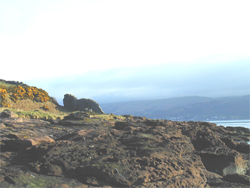 |
|
.... Lion Rock, Cumbrae Island, a
volcanic intrusion or dyke on the raised
.....beach.platform
between the Marine Station and the ferry. |
Return
LIMPETS
2003, MILLPORT, SCOTLAND
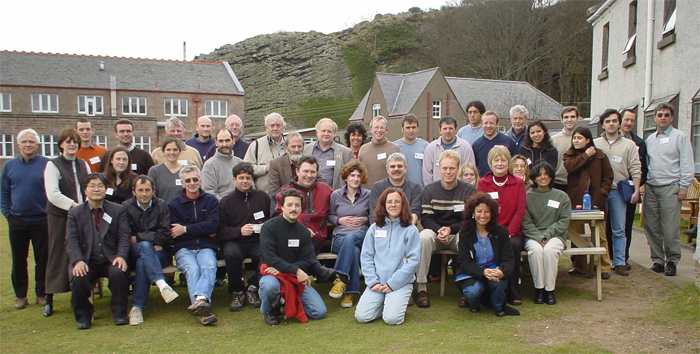
 .....Limpet
Group Key
.....Limpet
Group Key
1
John
Taylor, 2 Liz Platts,
3 Will Le Quesne, 4
Tomowo Ozawa, 5 Rogerio
Ferraz, 6 Liz Campbell,
7 Bernhard Ruthensteiner, 8
Derry Sinclair, 9 Emina
Begovic, 10 Alan Hodgson,
11 Richard Thompson,
12 Richard Hartnoll,
13 David Reid, 14
Brian Simison, 15 Max
Cledon, 16 Bill Bailey,
17 Robert Cameron,
18 Gerhard Haszprunar,
19 David Lindberg,
20 Claudia Magalhaes,
21 Julia Sigwart, 22
Mike Burrows, 23 Steve
Hawkins, 24 Rosanna
Aquino de Souza, 25
Russ Coleman, 26 Stuart
Jenkins, 27 Alex Nederbracht,
28 Sophie Pendlebury,
29 Laura Weber, 30
Free Espinosa Torre, 31
Mark Davies, 32 Linda
Robb, 33 Paula Moschella,
34 George Branch,
35 Madalena Branco, 36
Purba Pal, 37 Pedro
Ribiero, 38 Alexandra
Sa Pinto, 39 J Curdia,
40 Georges Dussart,
41 Hugh Jones.
Top,
from left: Emina Begovic receives the prize for best
student presentation from the incoming president Bill Bailey; part
of the posters display; evening in a local pub.
Bottom, from left: President,
Robert Cameron, and treasurer, Liz Platts, thank Hugh Jones for organizing
the meeting; Alan Hodgson, the co-organiser, between Richard Hartnoll
and Georges Dussart; Hugh Jones thanks the staff of Millport Station
for their efforts.
Return
BACK
